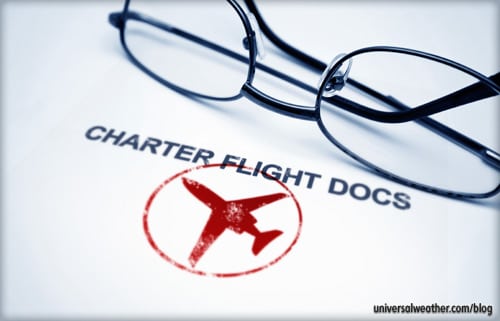Charter Flight Documents: Key Considerations for Charter Operators (Part 2)


This business aviation blog post is part of a series on charter flights and continues from Part 1 on Charter Flight Documents.
Charter (also known as non-scheduled commercial) permit-documentation needs differ by country. Be aware of lead times, requests for documentation, and special forms required from certain countries. The best practice is to source or create all required documents well in advance of your trip. Your 3rd-party provider will be able to confirm all necessary charter documentation required and can forward you templates or samples of documentation in cases where paperwork requirements may be unique.
1. What are examples of countries that require many charter documents?
Germany, U.K., France, and Italy have many documentation requirements in order to process charter permits. Charter operators who’ve never flown to Italy may be surprised at the lead time requirements and necessary documentation needed to process the permit. If you’re operating to Italy for the first time, or it’s been at least two years since your last flight into that country, 45 days is needed to process your charter permit. Japan mandates specific documents in order to process charter permits. When flying to Japan, for example, U.S.-based operators need a “Notice of Consistency” from the U.S. department of Transport. This document takes advance planning and time to process.
2. What are some examples of countries requiring special charter documentation?
Italy requires non-Italian registered charter operators to fill out a 20-page questionnaire every five years. This must be completed by a person who holds responsibility for the AOC, such as the Chief Operating Officer or the Director of Flight Operations. France requires operators to demonstrate a Safety Management System (SMS) approval. Canada has several stipulations on when a charter landing permit is or isn’t required. Always check in advance with your 3rd-party provider to determine if your specific trip requires a charter permit.
3. Are special forms required for charter permits?
There are situations where you’ll need to obtain special forms by particular Civil Aviation Authorities (CAAs). For example, you’ll need specific forms for operations into Israel and specific questionnaires for Italy, Germany and France. Some forms may be challenging for operators to obtain, including the ‘ad-hoc charter application’ for the Bahamas or the particular insurance wording/formats that Germany, Italy and Hong Kong each require.
4. Should I provide all restrictions/limitations regarding my operational specifications in advance?
Yes. It’s best to forward copies of your insurance and operations specifications to your 3rd-party provider assisting you with your charter permits, as these documents may limit your routing flexibility. If your operations specifications restrict countries you may overfly, this can lead to re-routes, additional jet fuel costs, additional permits, interference with crew duty time limitations, or initiate the need for a crew change. By knowing these restrictions well in advance, it will allow charter operators to create more accurate price quotes and avoid any possible mishaps. Any missing information or documentation could jeopardize a trip.
5. Do you recommend that documentation be obtained in advance for certain countries?
It’s always best to obtain documentation in advance so that trip processing goes as smoothly as possible. Some examples of documents that may take longer to obtain include items like the Australian security program, Canadian Air Operator Certificate and the Italian landing permit questionnaire.
6. Where can I get assistance with information on particular documents?
Your 3rd-party provider can assist in providing documentation examples and help identify any required documents that you may not be familiar with. Some documentation requirements, such as specific wording that must appear on insurance documents, can be unclear at times. By obtaining an example of how the document should appear (a visual aid), or template of a required document, can cut down on revisions needed.
7. Do some CAAs maintain documentation on file for future requests and does this cut down on permit processing time?
Some CAAs do keep documents on file, but it’s always suggested that operators not rely heavily on this. There are instances where a CAA will want to see copies of documents, even though they have the document on file. Mexican officials, for example, may want to see a copy of a Blanket Charter Permit, even though this permit is kept on file with Mexican CAA.
Conclusion
Always be proactive in confirming that documentation is correct and properly updated. This will help maintain compliance and maximize operational flexibility. To improve chances of having international charter permits issued in a timely manner, it’s always best practice to ensure that all documentation requirements are clearly understood and planned for well in advance.
Questions?
If you have any questions about this article, contact me at katherineperry@univ-wea.com.




